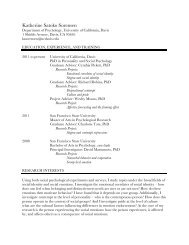The Psychology of Creativity:
The Psychology of Creativity:
The Psychology of Creativity:
You also want an ePaper? Increase the reach of your titles
YUMPU automatically turns print PDFs into web optimized ePapers that Google loves.
History <strong>of</strong> <strong>Creativity</strong> Research 17<br />
until Lehman (1953) returned to the same subject that Quételet had addressed, namely the relation between age and<br />
creative productivity. Probably the technique’s slow development can be ascribed to its highly distinctive approach.<br />
Rather than apply quantitative assessments to college students or clinical populations – ordinary, contemporary<br />
people – the psychologist quantifies the measures from historic personalities, many <strong>of</strong> whom may have died<br />
centuries ago. Yet this very distinctive line <strong>of</strong> attack makes historiometry especially well suited to the scientific<br />
study <strong>of</strong> creative geniuses (Simonton, 1999b). Historical data about world-famous creators can be quantified in<br />
much the same fashion as in psychometrics to discern the cognitive, personality, and biographical foundations <strong>of</strong><br />
truly exceptional creativity (see, e.g., Simonton, 1997b).<br />
Like psychometrics, historiometrics actually consists <strong>of</strong> an impressive diversity <strong>of</strong> measurement strategies<br />
(Simonton, 1990b). Of the inventory <strong>of</strong> available techniques, one has proven especially valuable: the content<br />
analysis <strong>of</strong> creative products. Creative geniuses stake their reputations on the products they leave behind (Albert,<br />
1975; Simonton, 1991). Accordingly, one route to comprehending their genius is to scrutinize the consequences <strong>of</strong><br />
that creativity, whether the product be a poem, play, painting, symphony, or scientific journal article. An especially<br />
exciting development in the application <strong>of</strong> content analysis to creative products has been the introduction <strong>of</strong><br />
computer programs. Computerized content analysis allows the researcher to study hundreds, even thousands <strong>of</strong><br />
creative products in an entirely objective manner. Colin Martindale (1975, 1990), for example, has content analyzed<br />
English and French poetry to discern the psychological basis for stylistic changes in the arts. Likewise, I have<br />
applied computerized content analysis to music (Simonton, 1980, 1989b) and literature (Simonton, 1989a, 1990a) to<br />
decipher the factors that cause a work to be deemed a masterpiece. <strong>The</strong> computer has even been used to determine<br />
the characteristics <strong>of</strong> high-impact research programs by analyzing the titles <strong>of</strong> scientific journal articles (Feist, 1993;<br />
Simonton, 1992).<br />
Humanistic <strong>Psychology</strong><br />
<strong>The</strong> 1960s saw the appearance <strong>of</strong> a major new movement in psychology, the humanistic. Humanistic<br />
psychologists viewed themselves as a “Third Force” reacting against the excesses <strong>of</strong> behaviorist and psychoanalytic<br />
psychologies. <strong>The</strong> movement’s proponents placed more emphasis on what makes healthy human beings distinct<br />
from the animals studied by the behaviorists and from the neurotic humans analyzed by the psychoanalysts. As a<br />
result, humanistic psychologists judged creativity to be a significant individual asset (May, 1975; Rogers, 1954).<br />
This virtue is evident in Abraham Maslow’s (1959) description <strong>of</strong> the self-actualizing person. <strong>The</strong> typical pr<strong>of</strong>ile
















